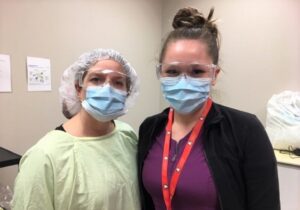Southwest Ontario Aboriginal Health Access Centre brings COVID-19 testing to select southwestern First Nations

By Colin Graf
DESHKAN ZIIBING (Chippewas of the Thames First Nation)— Coronavirus disease 2019 (COVID-19) testing is now taking place at the health centre here as the Southwest Ontario Aboriginal Health Access Centre (SOAHAC) is bringing testing to a cluster of three First Nations located just southwest of London.
Tests were first administered on Apr. 23 at the site and response has been “really good, steady,” says Jan Martin, SOAHAC’s Director of Indigenous Relations. Opening the site and making it more accessible is what is helping make the site successful. Martin explains that people who wish to be tested telephone the site and are given an appointment during the same afternoon or the next. The agency is also preparing to begin COVID-19 testing at its other locations in the cities of London, Windsor, and Owen Sound soon, with Windsor likely to start this week.
“Testing at all four sites will be open to all First Nations, Métis, and Inuit peoples, which will make the Thames site available to the neighbouring communities of Munsee Delaware Nation and Oneida of the Thames,” says Martin.
It has taken SOAHAC about three weeks to get the first site up and running, as time was needed to get enough testing kits and protective equipment for workers, she says. Employees are also partnering with Emergency Medical Service (EMS) from Oneida to provide mobile testing for people in the area with mobility barriers.
COVID-19 testing is available for all people in London at the Oakridge Arena, London, and the Carling Heights Optimist Community Centre. The SOAHAC site, when it is in operation, will be at the group’s regular offices.
SOAHAC is also working with Aamjiwnaang First Nation to train personnel to go into homes to administer tests.
“That’s the way they want to do it, and we’re just getting ready so we can go in,” Martin says.
The agency has offered their services to all First Nations in their area, from London north to Owen Sound, and west to the American border, she explains.
Two other southwestern First Nations are looking to establish testing centres in their communities. Chief Jason Henry of Chippewas of Kettle & Stony Point said he “wouldn’t be surprised” if a testing site was established there by May 1, in a video update to members on Apr. 24. He also said that things “look positive” about establishing a 12-unit isolation centre at Kettle & Stony Point in case things get worse, during his Apr. 22 update.
“In Bkejwanaong Territory (Walpole Island), there were three active COVID-19 cases as of Apr. 28, with five negative test results, and two test results pending,” says Operations Manager James Jenkins.
Jenkins adds that the patients with the illness are moving toward recovery. The community is taking steps to have its own testing centre through Lambton Public Health, but that is still a few weeks away, Jenkins notes.
“Since around mid-April, First Nations people have been prioritized for COVID-19 testing in Ontario and procedures have been simplified,” he says.
Things are a little easier now, even with a distance of at least 40 kilometres to the nearest testing centres in Chatham, Sarnia, or Petrolia, Jenkins claims. Community members can get a testing appointment directly after a screening phone call with the Walpole Health Centre if their symptoms warrant, he explains. Earlier in the pandemic, people who were concerned they might have the illness would have had to go to their physician, then possibly also to an emergency department before getting a testing appointment.
“Just think about arranging three trips like that for someone who doesn’t have their own transportation,” Jenkins asks us to imagine.
Things are “working fairly well” at the Health Centre in keeping up with calls, he says, although employees are “juggling things a bit” making sure staff are available after hours for calls. Jenkins adds that Health Centre workers are also tracing contacts of the positive cases on Walpole Island.


